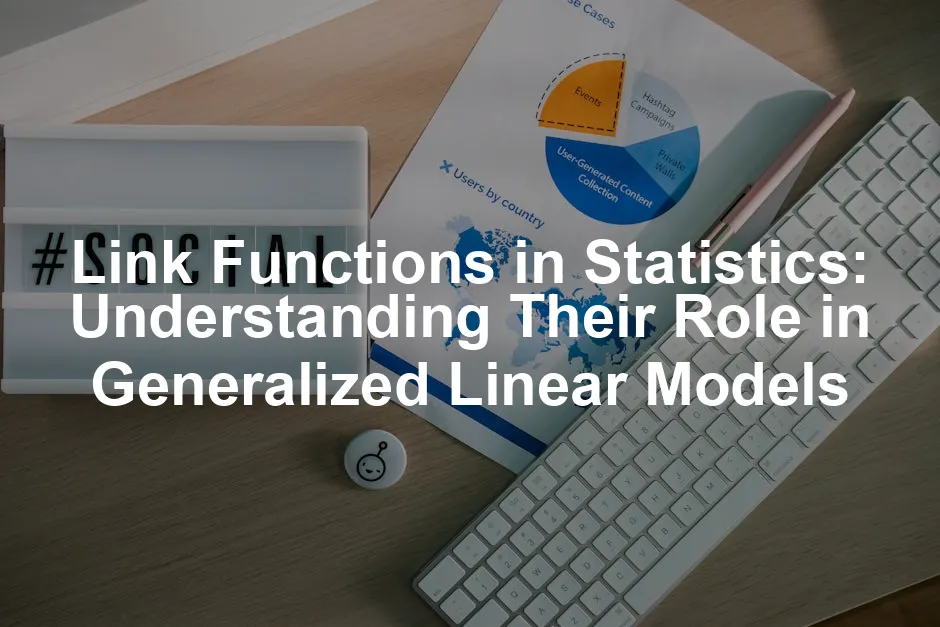Introduction
Link functions are the unsung heroes of statistical modeling. They bridge the gap between the linear predictors and the responses in Generalized Linear Models (GLMs). Imagine trying to fit a square peg into a round hole. Without a link function, modeling data distributions that aren’t normal is just as tricky!
GLMs are essential tools for statisticians. They extend traditional linear regression to handle various types of data distributions, such as binary, count, and continuous data. This flexibility is crucial, especially when data doesn’t conform to the normal distribution. For example, when analyzing the number of customer complaints, a GLM can provide insights that a standard linear regression might miss. Speaking of insights, if you want to dive deeper into the concepts behind these models, check out “The Art of Statistics: Learning from Data” by David Spiegelhalter. It’s a great resource for understanding data through a statistical lens!
The purpose of this article is to offer a comprehensive understanding of link functions and their applications in statistical modeling. By the end, you’ll see how these functions enhance our ability to model non-normal data accurately. So, buckle up, and let’s unravel the mystery of link functions together!

Understanding Generalized Linear Models (GLMs)
Overview of GLMs
Generalized Linear Models (GLMs) are versatile extensions of ordinary linear regression. They allow the response variable to have a distribution other than the normal distribution. A GLM consists of three main components: the random component, the systematic component, and the link function.
The random component specifies the probability distribution of the response variable. This could be normal for continuous data, binomial for binary outcomes, or Poisson for count data. The systematic component relates the predictors to the response through a linear predictor function. This is where link functions shine, paving the way for flexible model fitting.
GLMs are particularly valuable because they can accommodate various data distributions. For instance, when analyzing survey results, using a GLM with a binomial distribution allows for modeling the probability of a “yes” response based on different predictors, like age or income. If you’re looking for a practical guide to implementing these concepts, consider “Practical Statistics for Data Scientists” by Peter Bruce and Andrew Bruce. It covers essential concepts in a way that makes them easy to grasp!

Components of GLMs
Random Component
The random component defines the distribution of the response variable. This crucial part ensures that we’re accurately representing the data’s underlying structure. Common distributions include:
- Normal: Used for continuous outcomes.
- Binomial: Ideal for binary outcomes like success/failure.
- Poisson: Suitable for count data, such as the number of visits to a website.
Choosing the correct distribution is essential. It helps ensure that the model’s assumptions align with the data’s characteristics, leading to more reliable results. If you’re diving into data analysis, a solid “Data Science from Scratch” by Joel Grus can provide you with the foundational knowledge you need!

Systematic Component
The systematic component establishes the relationship between the predictors and the response variable. It is represented by a linear predictor, defined as \( \eta = X\beta \), where \( X \) is the matrix of independent variables and \( \beta \) are the model parameters.
This component is where the magic happens! By combining predictors linearly, we can capture the essence of the data. However, we need link functions to transform this relationship into something usable. If you’re interested in learning R for data science, check out “R for Data Science” by Hadley Wickham and Garrett Grolemund. It’s a fantastic resource to get started!

Link Function Definition
Now, let’s clarify what a link function is. A link function is a mathematical function that connects the mean of the response variable to the linear predictor. It transforms the predicted values to ensure they fit within the acceptable range for the given distribution.
For example, in logistic regression, we use the logit link function. It transforms probabilities, which range from 0 to 1, into the entire real line. This ensures that we can model the relationship between predictors and probabilities effectively. If you’re looking for a more in-depth understanding of statistics, consider picking up “Naked Statistics” by Charles Wheelan. It’s a witty and engaging read!

In summary, link functions are vital in GLMs, allowing for flexibility in modeling various types of data. They enable statisticians to derive meaningful insights from non-normal distributions, making them invaluable tools in data analysis. Understanding these components sets the stage for applying GLMs effectively in real-world scenarios!
Importance of Link Functions in Statistical Modeling
Why Use Link Functions?
Link functions are essential in Generalized Linear Models (GLMs). They help us model non-normal data effectively. Why do we need them? Well, the real world is messy. Data often comes in forms that don’t fit neatly into our beloved normal distribution. Think about binary outcomes, counts, or proportions. Without link functions, we’d struggle to make accurate predictions.
Imagine you’re trying to predict the probability of someone voting. The response variable here is binary: yes or no. A standard linear regression would assume that this probability could be any value from negative infinity to positive infinity. Spoiler: it can’t! Probabilities must stay between 0 and 1. Here’s where link functions save the day. They transform our predictions to fit within the valid range of the response variable.
Link functions accomplish this by mapping the mean of the response variable to the linear predictor. This means that they effectively “link” the linear combination of our predictors to the expected value of our outcome. So, whether we’re dealing with counts or proportions, link functions ensure our model predictions are sensible and realistic. If you’re looking to dive deeper into statistical analysis, you might want to check out “Statistics for Data Science” by James D. Miller. It’s a practical guide that simplifies complex concepts!

Types of Link Functions
Commonly Used Link Functions
- Logit Link: This is the superhero of binary data. Used in logistic regression, it transforms probabilities into log-odds, allowing predictions to stay within the 0 to 1 range.
- Log Link: Perfect for count data, the log link transforms predictions using a logarithmic function. It keeps our predictions positive, which is crucial when we’re counting occurrences—no one wants to predict negative fish!
- Identity Link: This is the simplest link function. It’s used when our response variable is normally distributed. Essentially, it means the model predicts the outcome directly, with no transformation needed.
- Probit and Cloglog Links: Probit is another option for binary outcomes. It uses the cumulative distribution function of the standard normal distribution. On the other hand, the complementary log-log link (cloglog) is useful for survival data, modeling the time until an event occurs.
Choosing the Right Link Function
Selecting the appropriate link function is crucial. It’s not a one-size-fits-all situation. When picking a link function, consider the nature of your response variable.
- Data Distribution: Identify if your data is binary, count, or continuous. This will guide your choice. For binary outcomes, the logit or probit links are ideal. If you’re working with counts, the log link is your best friend.
- Response Variable Characteristics: Think about the characteristics of your response variable. If it’s strictly positive, the log link will help ensure that predictions never dip into the negatives.
- Model Fit: After selecting a link function, it’s essential to validate your choice through model diagnostics. Check for goodness-of-fit and residual patterns. If the model isn’t performing well, it might be time to revisit your link function.

In summary, link functions are vital components of GLMs. They allow us to model various types of data accurately while ensuring our predictions make sense in the context of the response variable. Choosing the right link function based on data characteristics enhances our models, leading to more accurate and meaningful insights. So, the next time you’re faced with non-normal data, remember: link functions are your allies!
Poisson Regression
Poisson regression is a statistical technique used for modeling count data. This model is particularly useful when the response variable represents counts of events occurring within a fixed period or space. The log link function is employed to ensure that the predicted counts remain non-negative.
Imagine you’re analyzing the number of customers visiting a cafe each hour. If you fit a Poisson regression model, you’ll use the log link function to transform the linear predictor into the expected count. This transformation guarantees that the predicted counts, which must be zero or greater, stay within this valid range.
Here’s a practical example: Suppose you collect data on the number of customers visiting your cafe during different hours of the day. You might have predictors like the day of the week, weather conditions, and local events. By fitting a Poisson regression model with a log link, you create a formula like this:
\[ \log(\lambda) = \beta_0 + \beta_1 \text{(Day)} + \beta_2 \text{(Weather)} + \beta_3 \text{(Events)} \]
Here, \( \lambda \) represents the expected number of customers. After fitting this model, you can exponentiate the results to interpret them as counts, ensuring they’re always non-negative. If you’re interested in hands-on learning, check out “Hands-On Machine Learning with Scikit-Learn, Keras, and TensorFlow” by Aurélien Géron. It’s a fantastic resource for practical implementation!

The log link function is essential because it transforms the linear predictor into a scale that ensures predictions are appropriate for the context of count data. Without this transformation, predictions could easily fall into the negative realm, which is unthinkable when discussing counts!
Other Applications
Link functions are not just limited to Poisson regression. Other statistical models, such as negative binomial regression and generalized additive models, also utilize link functions.
Negative binomial regression is helpful when the count data exhibit overdispersion, meaning the variance exceeds the mean. It employs a log link function similar to Poisson regression, but adds an extra parameter to account for this overdispersion. If you’re looking to explore statistical learning, consider “The Elements of Statistical Learning” by Trevor Hastie, Robert Tibshirani, and Jerome Friedman. It’s a comprehensive resource for advanced learning!

Generalized additive models (GAMs) extend the flexibility of GLMs by allowing non-linear relationships between predictors and the response variable. They can use various link functions depending on the nature of the data, enabling a more nuanced approach to modeling complex relationships.
In conclusion, link functions are versatile tools in statistical modeling, enhancing the accuracy and interpretability of various regression models.
Evaluating Link Functions
When selecting a link function for your model, several criteria come into play. First, consider the nature of your response variable. Does it fall within a bounded range, like probabilities (0 to 1), or is it count data? For binary outcomes, the logit link is often preferred. It accurately maps probabilities to the entire real line, making predictions manageable.
Next, assess the distribution of your data. Each link function corresponds to specific distributions. For instance, a log link function works best with Poisson-distributed count data. Ensure your chosen link function aligns with the underlying distribution of your response variable for optimal model performance.
Model fit is another crucial criterion. After fitting your model, conduct diagnostics to evaluate how well it performs. Look for residual patterns and use goodness-of-fit tests. If the diagnostics indicate poor fit, consider refining your model by trying different link functions or adjusting your predictors.

Iterative testing and validation are key to refining your models. Begin with a preliminary model and analyze its performance. If the results don’t meet your expectations, tweak your model. This might involve changing the link function or revisiting your choice of predictors. If you want to keep your analysis organized, consider using a Data Analysis Notebook to track your findings!

Cross-validation is an excellent method for assessing model performance. By splitting your data into training and testing sets, you can evaluate how well your model generalizes to unseen data. This process helps identify any overfitting issues, ensuring your model remains robust.
Finally, always keep track of your changes and their impacts. Documenting your iterative process will help you understand which link functions work best for specific datasets. Over time, you’ll develop a keen intuition for selecting the most appropriate link functions for your models.
Conclusion
In this article, we explored the pivotal role of link functions in Generalized Linear Models (GLMs). We began by understanding that link functions bridge the gap between linear predictors and response variables. This allows us to model non-normal data effectively, which is essential for accurate statistical analysis.
We discussed various types of link functions, including the logit, log, and identity links. These functions help us handle different data distributions, ensuring predictions remain within valid ranges. Choosing the appropriate link function based on the nature of your data is crucial. Whether your response variable is binary, count-based, or continuous, there’s a link function designed to facilitate accurate modeling. If you’re still wondering how to apply these concepts practically, you might find “Bayesian Data Analysis” by Andrew Gelman et al. to be an insightful read!

Iterative testing and validation emerged as essential practices for refining models. By continually assessing model fit through diagnostics and cross-validation, you can enhance your GLM’s performance. This iterative process allows for adjustments that lead to better-fitting models, ultimately improving the quality of your analysis.
Understanding link functions significantly impacts statistical modeling. They provide the necessary flexibility to handle diverse data types, which is vital in real-world data analysis. By applying these concepts, you can elevate your data analysis projects to new heights. To help keep your workspace organized, consider investing in a quality Professional Notebook to jot down your findings!

So, as you embark on your data analysis journey, remember the importance of link functions. They are not just mathematical tools; they are the keys that unlock the potential of your data. Embrace the insights gained from this article and apply them to your own projects. Whether you’re predicting customer behavior, analyzing survey results, or modeling counts, the right link function can make all the difference. Happy modeling!
FAQs
What is a link function in statistics?
A link function in statistics connects predictors in a Generalized Linear Model (GLM) with the expected value of the response variable. It transforms the non-linear relationship into a linear one, allowing statisticians to fit models to various types of data. Essentially, it acts as a bridge between the model’s random and systematic components, ensuring that predictions align with the data’s distribution.
Why are link functions necessary in GLMs?
Link functions are vital for accommodating different data distributions in GLMs. For example, binary outcomes like success/failure cannot be modeled directly using linear regression because they only fall between 0 and 1. A link function ensures the predicted values fall within the appropriate range according to the distribution. This flexibility allows for accurate modeling of non-normal data, enhancing the model’s overall predictive power.
How do I choose the right link function for my model?
Selecting the right link function requires understanding your data’s characteristics. Start by identifying the nature of your response variable. If it’s binary, consider using the logit or probit link functions. For count data, the log link is often suitable. Always validate your choice by checking model fit. Diagnostics such as residual analysis can help ensure your link function appropriately captures the relationship between predictors and the response.
Can link functions affect model interpretation?
Absolutely! Different link functions can significantly impact how you interpret model coefficients. For instance, in logistic regression using a logit link, coefficients represent changes in the log odds of the outcome. Understanding this transformation is crucial for accurate interpretation. If you switch to a probit link, the interpretation shifts to changes in the probability of the outcome. Therefore, be mindful of how the choice of link function shapes your insights.
What are some common mistakes when using link functions?
One common pitfall is selecting a link function without considering the data’s distribution. This can lead to poor model fit and misleading results. Another mistake is failing to validate the chosen link function through diagnostics. Always check for residual patterns and goodness-of-fit metrics. Ignoring these aspects can result in overfitting or underfitting the model, which compromises its reliability and interpretability.
Please let us know what you think about our content by leaving a comment down below!
Thank you for reading till here 🙂
For a deeper understanding of the role of link functions in statistical modeling, you can explore the link functions statistics.
To learn about the latest insights and methods, check out the emerging trends in statistical analysis of identically distributed data.
All images from Pexels




